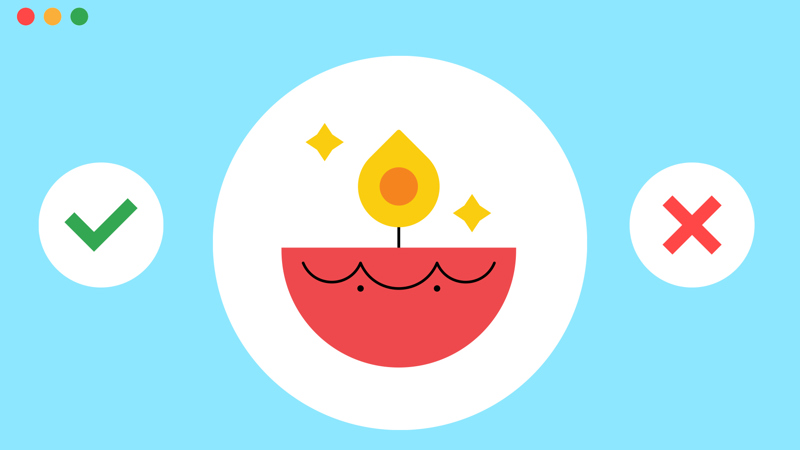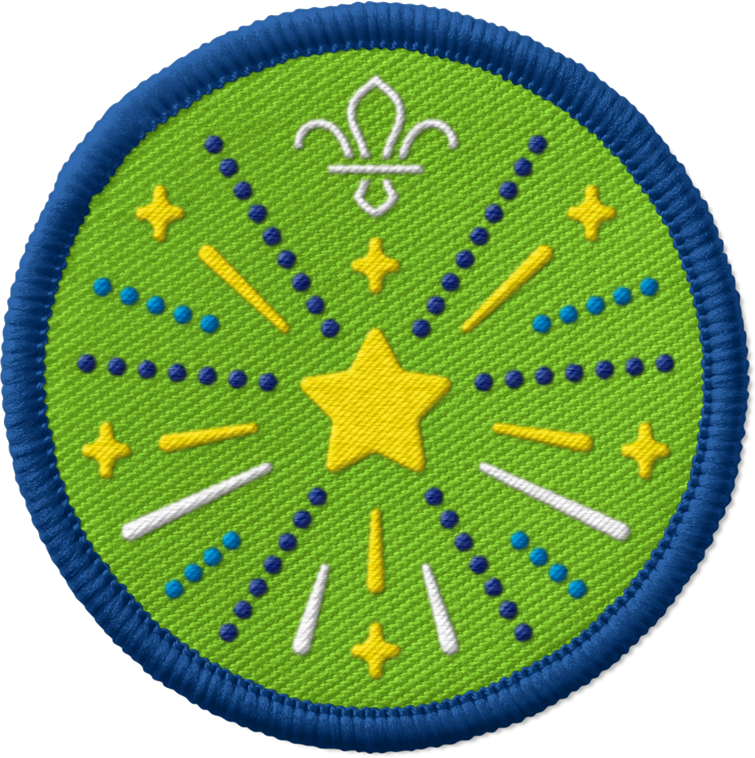
Make a diya lamp
You’ll need
- Air-drying clay
- Paint brushes
- Something to protect surfaces (for example, newspaper or tablecloths)
- Paint suitable for clay
- Clay tools (or alternatives, such as glue spreaders)
- LED tea lights
Before you begin
- Use the safety checklist to help you plan and risk assess your activity. Take a look at our guidance to help you carry out your risk assessment, including examples.
- Make sure all young people and adults involved in the activity know how to take part safely.
- Make sure you’ll have enough adult helpers. You may need some parents and carers to help if you’re short on helpers.
Scouts is open to everyone. We don’t identify exclusively with one faith, and we welcome people of all faiths and of none.
We know it’s important for people to learn about each other, including understanding different faiths and beliefs. Scouts always respects people’s beliefs, faiths and cultures, and everyone should be open to learn.
As an inclusive and values based movement, we support our members to engage and learn about different faiths and beliefs in an exciting and meaningful way, even if they don’t have a faith themselves.
Celebrating and understanding differences, including differences in faiths and beliefs, is an important part of our Scout values, which are:
- Integrity: We act with integrity; we are honest, trustworthy and loyal.
- Respect: We have self-respect and respect for others.
- Care: We support others and take care of the world in which we live.
- Belief: We explore our faiths, beliefs and attitudes.
- Co-operation: We make a positive difference; we co-operate with others and make friends.
Our value of Belief and its exploration helps Scouts to learn from other faiths and beliefs. This encourages them to develop or build their personal beliefs and understand their shared values, whether faith-based on not.
We know that learning about faiths, beliefs and different attitudes can help to break down barriers, helps us all to recognise what we have in common, and teaches us to value and respect other people. It also helps us to build up respect, acceptance and knowledge for each other, leading to a more co-operative and inclusive society.
In our diverse society, people can sometimes feel cautious talking about this sensitive subject. However, it's important that Scouts offers young people safe, exciting and open spaces to explore faiths and beliefs. They should be able to engage in personal reflection, as they question and develop their opinions and understanding of the world around them.
Making time for personal reflection and developing our beliefs means exploring the places, people, communities, celebrations or stories which hold meaning for us, and it may not necessarily mean exploring a faith.
For example, someone’s shared values may be their Scout Values and that person may choose to reflect on them at important times, such as when they make their Promise. Others may choose to reflect at certain times of the year, such as a faith-based festival, birthdays, meaningful events or at New Year. Some people may still celebrate events, such as Christmas, but use it as a time to celebrate family, friends and loved ones, as well as for charity and giving.
Discover more about Faiths and Beliefs in Scouts.
What’s Diwali?
- Diwali is also known as Deepavali. The customary greeting associated with Diwali is ‘Shubh Deepavali’, which means ‘Happy Diwali’.
- Diwali marks the Hindu New Year. It's the largest and most celebrated festival in India, and is widely celebrated across the world, including in the UK.
- Diwali is around October or November and lasts around 5 days The exact date varies each year as the Hindu calendar's based on the Moon.
- The word Diwali means 'rows of lighted lamps'.
- Diwali's known as the 'festival of lights' because houses, shops and public places are decorated with small oil lamps called 'diyas'.
- It signifies the victory of good over evil, light over darkness and knowledge over ignorance.
Who’s Diwali celebrated by?
- Originally a Hindu festival, Diwali's also celebrated by Jains, Sikhs and some Buddhists. Each religion marks different historical events and stories.
- Hindus celebrate the deities Rama and Sita returning to Ayodhya after their 14-year exile. They also celebrate the day Mother Goddess Durga destroyed a demon called Mahisha.
- Sikhs particularly celebrate the release from prison of the sixth guru Hargobind Singh in 1619. But, Sikhs celebrated the festival before this date. The foundation stone of the Golden Temple at Amritsar, the most holy place in the Sikh world, was laid on Diwali in 1577!
- The founder of Jainism's Lord Mahavira. During Diwali, Jains celebrate the moment he reached a state called Moksha or Nirvana, which both mean eternal bliss.
- For many people, Diwali honours Lakshmi, who's the goddess of wealth. Lamps are lit and windows and doors are left open to help Lakshmi find her way into people's homes.
- During Diwali, people make patterns, called rangoli, from colourful materials like powders and pastes.
- Other ways that people celebrate the festival include spring-cleaning their home. People believe that if their house is clean and there are diya lamps to light the way, Lakshmi will visit their home and bring them good fortune for the coming year.
- Diwali brings communities together, to celebrate light overcoming darkness and good defeating evil.
- Many people celebrate by exchanging gifts (often sweets and dried fruits), decorating buildings with lights, sharing festive meals, wearing new clothes, singing, dancing and going to firework displays.
- It's also a time to thank Lakshmi for everything they have. Many people do this by giving money and food to those in need. This is called dana.
- During Diwali, places of worship are also decorated with lights. Murtis (images or statues of the Hindu gods or goddesses) are dressed in new clothes and offered food. People believe Lakshmi will bless the food (Prasad), which will be shared out amongst the community.
Rama and Sita's one of the main stories from Hinduism. This story's connected with Diwali.
- A long time ago, Rama, a great warrior prince, was married to a beautiful princess called Sita.
- Rama and Sita lived near an evil king, who was called Ravana. He had ten heads and twenty arms.
- Ravana wanted to marry Sita, so he kidnapped her and flew off with her in his chariot.
- Rama realised that Sita had been kidnapped. He went looking for her, and he met the monkey god Hanuman in the forest.
- Hanuman agreed to look for Sita, and he eventually found her on the island of Lanka. She was imprisoned in a beautiful garden.
- Hanuman gathered his monkey army and they prepared to battle Ravana.
- Rama and Hanuman began to battle Ravana. However, it was a massive battle and it seemed like Ravana would win.
- However, Rama produced a magical golden arrow and fired it at Ravana. It hit him in the chest.
- With Ravana defeated, Rama and Sita were reunited.
- Rama and Sita returned home. They found that everyone had lit lamps to guide them home. This's why people light lamps on Diwali!
Making a Diya
- Gather everyone in a circle and show everyone how to complete each step of the instructions to make their Diya. You could write out the instructions for everyone to follow, too.
- Everyone should get a piece of clay and roll it into a ball, so it's about five centimetres wide.
- Make a hole in the top of the ball using your thumb. Using your thumb, gradually make the hole bigger, until the clay starts to look like a small bowl. It needs to be just big enough to fit a small tealight inside, but it shouldn't be too deep. The wick of the candle should stick still be visible out of the top of the bowl.
- Shape the bowl by pinching the clay on one side. This should create a point at the front, a bit like a boat.
- Make sure the bottom of the clay is flat, so it sits nicely on the table.
- Use tools (or just your fingers) to decorate the outside of the Diya with patterns.
- Leave the finished lamps to dry. If your clay isn’t air-drying, everyone should ask an adult to help bake them in an oven to harden the clay.
- Once the lamps are dry, you can paint and decorate them, before leaving them to dry.
- When the paint is dry, you can add a tealight to your diya. Did you know diyas traditionally use cotton wicks dipped in oil?
Learn about Diwali
- Tell everyone you’re going to create a quiz for Diwali.
- Everyone should come up with an action to represent ‘true’ and an action to represent ‘false’. You could do thumbs up and thumbs down, try to make a T or an F with your arms, or move to different sides of the meeting place.
- Read out a statement about Diwali. It might be true or it might be false. We've included some ‘true or false statements’ on this page to help you get started.
- If players think the statement is true, they should do the action for true. If they think it's false, they should do the action for false.
- Tell everyone whether it's true or false and explain why.
- Everyone should return to a neutral position and get ready to play again using another statement.
True or false quiz statements
- Diwali always happens in August in the UK: False. The exact date changes every year depending on the moon, but Diwali's in October or November.
- The goddess of wealth is called Sita: False. The goddess of wealth is called Lakshmi. Sita is the princess who was kidnapped by Hanuman. She was rescued by Hanuman and returned home with Rama.
- The word Diwali means 'rows of lighted lamps': True.
- Only Hindus celebrate Diwali: False. As well as Hindus, some Sikhs, Jains and a smaller number of Buddhists celebrate Diwali. For each faith, it marks different historical events and stories.
- At Diwali, some Hindus celebrate Rama and Sita returning to the city of Ayodhya. Rama defeated the evil king Ravana and rescued Sita: True.
- At Diwali, some Sikhs celebrate the birth of Guru Hargobind: False. Some Sikhs celebrate Guru Hargobind being released from prison, along with 52 other princes.
- Many people believe that lights and lamps help the Hindu goddess Lakshmi into people’s homes: True. She's the goddess of wealth. People hope she will bring them wealth, comfort or peace.
- To celebrate Diwali, people set off fireworks and wear new clothes: True.
- A special type of curry is eaten as the main Diwali food: False. There are lots of special Diwali foods, but one of the main ones is sweets. They can be made from ingredients including flour, beans, milk or yoghurt, nuts and spices.
- Colourful patterns created using coloured rice, colourful powders and flower petals are called rangoli: True.
- Dana is giving money and food to those in need: True
- Mandir is the name of the images or statues of the Hindu gods or goddesses, which are dressed in new clothes and offered food: False - Murtis is the name of images or statues of the Hindu gods or goddesses. Mandir is the name of Hindu places of worship.
Reflection
This activity reminded everyone that they’re a local, national, and international citizen. Are there any similarities between Diwali and any festivals or celebrations people take part in? Are there any other festivals or celebrations that people would like to find out more about? Diwali is a time to think about others and people in need – is that a responsibility everyone shares, no matter their background?
This activity also encouraged everyone to respect and trust people from different backgrounds. How could everyone respect people who’re celebrating Diwali? Why is it important that people learn about festivals and celebrations that they don’t celebrate? Did anyone learn anything surprising about Diwali? How would people feel if they were invited to a Diwali celebration?
Safety
All activities must be safely managed. You must complete a thorough risk assessment and take appropriate steps to reduce risk. Use the safety checklist to help you plan and risk assess your activity. Always get approval for the activity, and have suitable supervision and an InTouch process.
- Sharp objects
Teach young people how to use sharp objects safely. Supervise them appropriately throughout. Store all sharp objects securely, out of the reach of young people.
- Food
Remember to check for allergies, eating problems, fasting or dietary requirements and adjust the recipe as needed. Make sure you’ve suitable areas for storing and preparing food and avoid cross contamination of different foods. Take a look at our guidance on food safety and hygiene.
- Some people might not like the feeling of clay on their hands. You could have gloves available for people to use to mould the clay.
- For anyone who finds making the diya lamp difficult, you could have pre-made diya lamps for people to decorate.
All Scout activities should be inclusive and accessible.
If you enjoyed this activity, you could try our other Diwali activities. You may want to look at our badges to do with World Faiths.
If you’ve any members in your group who celebrate Diwali, you could offer them the opportunity to share their experiences, but only if they want to and are comfortable to do so. You may want to ask or chat to them before the session, so they don’t feel put on the spot or singled out.



